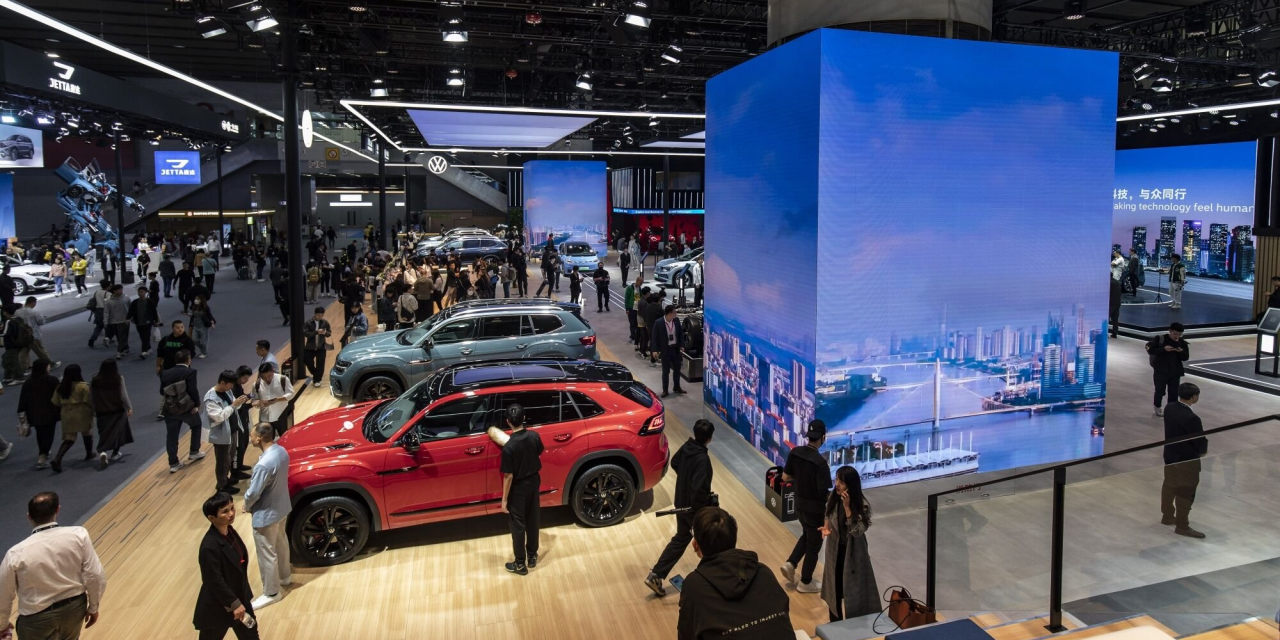Challenges Facing Foreign Automakers In China: Lessons From BMW And Porsche

Table of Contents
Navigating the Complex Regulatory Landscape in China
The Chinese automotive market is characterized by a stringent and intricate regulatory framework. Foreign companies must master this landscape to succeed.
Stringent Emission Standards and Environmental Regulations
China implements increasingly strict emission standards, significantly impacting production costs and necessitating technological adaptation.
- China VI emission standards: These stringent regulations mandate significant investment in cleaner vehicle technologies. Failure to comply results in hefty fines and market exclusion.
- Fuel efficiency targets: Manufacturers are under pressure to meet aggressive fuel economy targets, further increasing development and production costs.
- Electric vehicle mandates: The government actively promotes electric vehicles (EVs), requiring automakers to allocate resources towards EV development and production to meet quota requirements.
BMW, for instance, has invested heavily in its electrification strategy in China, launching several EV models tailored to the Chinese market and collaborating with local battery suppliers to meet local content requirements and reduce its carbon footprint. Similarly, Porsche has introduced its Taycan EV model, adapting it for the Chinese market to comply with regulations and consumer preferences.
Bureaucracy and Licensing Procedures
Obtaining the necessary licenses and permits for market entry and expansion can be a protracted and complex process in China.
- Lengthy approval processes: The approval process for new models and technologies can be significantly longer than in other markets.
- Multiple government agencies: Automakers must interact with numerous government bodies, increasing administrative burden and potential for delays.
- Compliance requirements: Meeting all the bureaucratic requirements necessitates significant resources and expertise.
The complexities of navigating these processes can lead to delays in market entry and expansion, providing a significant advantage to already-established players. For example, while not publicly documented as a specific roadblock, the sheer complexity of navigating the Chinese regulatory environment likely contributed to the overall timing of market entry and expansion strategies for both BMW and Porsche.
Local Content Requirements
China mandates a certain percentage of locally sourced parts for vehicles sold within the country. This creates significant challenges in establishing robust and reliable supply chains.
- Supplier relationships: Building strong relationships with local suppliers is crucial to meeting local content requirements.
- Quality control: Ensuring the quality of locally sourced components is paramount to maintaining product standards.
- Supply chain resilience: Managing potential disruptions to the local supply chain is critical for sustained production.
BMW and Porsche have addressed this through joint ventures and strategic partnerships with Chinese component manufacturers, facilitating access to local supply chains while ensuring quality control. These collaborations not only help meet local content requirements but also provide valuable insights into the local market and consumer preferences.
Intense Competition and the Rise of Domestic Brands
The Chinese automotive market is characterized by intense competition, particularly from rapidly growing domestic brands.
Aggressive Pricing Strategies of Chinese Automakers
Domestic brands often adopt aggressive pricing strategies, putting pressure on the profit margins of foreign automakers.
- Price wars: Competition can lead to price wars, impacting the profitability of foreign brands.
- Value-for-money propositions: Chinese brands often offer attractive value-for-money propositions, challenging the premium positioning of foreign brands.
- Market share battles: Foreign brands need to carefully balance pricing and profitability to maintain market share.
BMW and Porsche respond by strategically positioning their products to appeal to specific market segments, emphasizing brand prestige, advanced technologies, and superior driving experiences to justify premium pricing.
Rapid Innovation and Technological Advancements by Chinese Brands
Chinese automakers are rapidly innovating and adopting cutting-edge technologies, challenging the established dominance of foreign brands.
- Electric vehicle technology: Chinese companies are leading in several aspects of EV technology, such as battery technology and charging infrastructure.
- Autonomous driving systems: Significant advancements are being made in autonomous driving systems by Chinese brands.
- Connectivity and infotainment: Chinese automakers are integrating advanced connectivity and infotainment features into their vehicles.
This rapid innovation necessitates foreign automakers to continuously invest in research and development to maintain their competitive edge.
Understanding Chinese Consumer Preferences
Understanding the unique preferences of Chinese consumers is critical for success in the market.
- Brand perception: Certain brands are particularly favored by Chinese consumers.
- Feature preferences: Specific features and functionalities are highly valued by Chinese consumers.
- Technological preferences: Consumer preferences related to technology vary from those in other regions.
BMW and Porsche have conducted extensive market research to understand these preferences, adapting their products and marketing strategies accordingly. For example, they might offer bespoke features or design elements tailored to Chinese aesthetics or integrate preferred technological solutions.
Supply Chain Disruptions and Geopolitical Risks
Foreign automakers operating in China face potential risks from global supply chain disruptions and geopolitical uncertainties.
Global Supply Chain Challenges and their Impact on Production
Global events like pandemics and trade wars can significantly disrupt the availability of parts and materials, impacting production schedules.
- Raw material shortages: Disruptions in the supply of raw materials can severely impact production.
- Logistics bottlenecks: Global shipping delays and logistical challenges can further exacerbate production difficulties.
- Component shortages: Shortfalls in essential components can halt production lines.
BMW and Porsche mitigate these risks by diversifying their supply chains, building strategic partnerships with suppliers in multiple regions, and developing robust contingency plans to address potential disruptions.
Geopolitical Tensions and Their Influence on Business Operations
Geopolitical tensions and trade disputes can negatively influence business operations in China.
- Trade wars and tariffs: Trade disputes can lead to increased tariffs and trade restrictions.
- Political instability: Political uncertainties and instability can create an unpredictable business environment.
- Regulatory changes: Unexpected changes in regulations can disrupt business operations.
Foreign automakers need to actively monitor geopolitical developments and adapt their strategies accordingly, fostering strong relationships with government entities and staying informed about regulatory changes.
Conclusion: Key Takeaways and Call to Action
The challenges facing foreign automakers in China are significant, encompassing a complex regulatory landscape, fierce competition, rapid technological advancements, and geopolitical risks. The experiences of BMW and Porsche illustrate the importance of understanding and adapting to these unique aspects of the Chinese market. Successfully navigating this market requires a strategic approach that emphasizes compliance with regulations, competitive pricing and product adaptation, resilient supply chains, and a deep understanding of Chinese consumer preferences.
To achieve sustainable growth in this crucial market, further research into the intricacies of the Chinese automotive industry is essential. Understanding the evolving regulatory environment, adapting to the rapid pace of innovation, and managing potential supply chain and geopolitical risks are key to success. Learn more by exploring resources on the China Automotive Manufacturers Association website and staying updated on industry publications specializing in the Chinese automotive sector. Don't let these challenges facing foreign automakers in China deter you; seize the immense opportunities with informed strategic planning.

Featured Posts
-
 Broadcoms V Mware Acquisition A 1050 Price Hike Claim Sparks Outrage
Apr 23, 2025
Broadcoms V Mware Acquisition A 1050 Price Hike Claim Sparks Outrage
Apr 23, 2025 -
 Mlb Record Reds Unusual Losing Streak Continues With 1 0 Loss
Apr 23, 2025
Mlb Record Reds Unusual Losing Streak Continues With 1 0 Loss
Apr 23, 2025 -
 Trumps Absence In Key Economic Indicators
Apr 23, 2025
Trumps Absence In Key Economic Indicators
Apr 23, 2025 -
 Arizona Diamondbacks Secure 5 2 Win Against Milwaukee Brewers
Apr 23, 2025
Arizona Diamondbacks Secure 5 2 Win Against Milwaukee Brewers
Apr 23, 2025 -
 Tigers Fall To Brewers In Series Finale Keider Monteros Performance
Apr 23, 2025
Tigers Fall To Brewers In Series Finale Keider Monteros Performance
Apr 23, 2025
Latest Posts
-
 Is Benson Boone Copying Harry Styles The Singer Responds
May 10, 2025
Is Benson Boone Copying Harry Styles The Singer Responds
May 10, 2025 -
 Harry Styles Snl Impression Backlash How He Really Feels
May 10, 2025
Harry Styles Snl Impression Backlash How He Really Feels
May 10, 2025 -
 Addressing The Controversy Benson Boone And Harry Styles Comparisons
May 10, 2025
Addressing The Controversy Benson Boone And Harry Styles Comparisons
May 10, 2025 -
 Harry Styles Response To A Bad Snl Impression
May 10, 2025
Harry Styles Response To A Bad Snl Impression
May 10, 2025 -
 Harry Styles Reacts To A Subpar Snl Impression
May 10, 2025
Harry Styles Reacts To A Subpar Snl Impression
May 10, 2025
